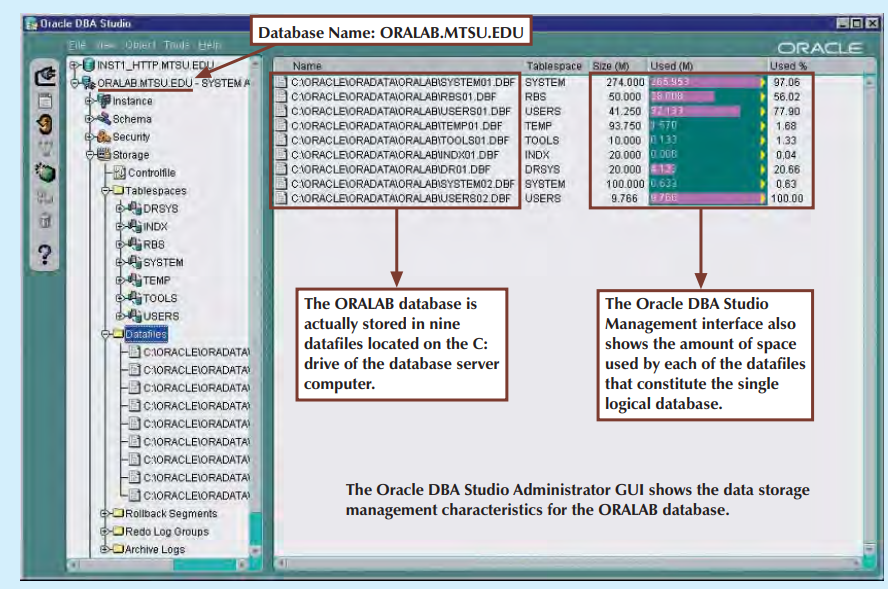A DBMS performs several important functions that guarantee the integrity and consistency of the data in the database. Most of those functions are transparent to end users, and most can be achieved only through the use of a DBMS. They include data dictionary management, data storage management, data transformation and presentation, security management, multiuser access control, backup and recovery management, data integrity management, database access languages and application programming interfaces, and database communication interfaces

- Data dictionary management. The DBMS stores definitions of the data elements and their relationships (metadata) in a data dictionary. In turn, all programs that access the data in the database work through the DBMS. The DBMS uses the data dictionary to look up the required data component structures and relationships, thus relieving you from having to code such complex relationships in each program. Additionally, any changes made in a database structure are automatically recorded in the data dictionary, thereby freeing you from having to modify all of the programs that access the changed structure. In other words, the DBMS provides data abstraction, and it removes structural and data dependence from the system
- Data storage management. The DBMS creates and manages the complex structures required for data storage, thus relieving you from the difficult task of defining and programming the physical data characteristics. A modern DBMS provides storage not only for the data, but also for related data entry forms or screen definitions, report definitions, data validation rules, procedural code, structures to handle video and picture formats, and so on. Data storage management is also important for database performance tuning. Performance tuning relates to the activities that make the database perform more efficiently in terms of storage and access speed. Although the user sees the database as a single data storage unit, the DBMS actually stores the database in multiple physical data files Such data files may even be stored on different storage media. Therefore, the DBMS doesn’t have to wait for one disk request to finish before the next one starts
- Data transformation and presentation. The DBMS transforms entered data to conform to required data structures. The DBMS relieves you of the chore of making a distinction between the logical data format and the physical data format. That is, the DBMS formats the physically retrieved data to make it conform to the user’s logical expectations. For example, imagine an enterprise database used by a multinational company. An end user in England would expect to enter data such as July 11, 2010, as “11/07/2010.” In contrast, the same date would be entered in the United States as “07/11/2010.” Regardless of the data presentation format, the DBMS must manage the date in the proper format for each country
- Security management. The DBMS creates a security system that enforces user security and data privacy. Security rules determine which users can access the database, which data items each user can access, and which data operations (read, add, delete, or modify) the user can perform. This is especially important in multiuser database systems , Database Administration and Security, examines data security and privacy issues in greater detail. All database users may be authenticated to the DBMS through a username and password or through biometric authentication such as a fingerprint scan. The DBMS uses this information to assign access privileges to various database components such as queries and reports
- Multiuser access control. To provide data integrity and data consistency, the DBMS uses sophisticated algorithms to ensure that multiple users can access the database concurrently without compromising the integrity of the database
- Backup and recovery management. The DBMS provides backup and data recovery to ensure data safety and integrity. Current DBMS systems provide special utilities that allow the DBA to perform routine and special backup and restore procedures. Recovery management deals with the recovery of the database after a failure, such as a bad sector in the disk or a power failure. Such capability is critical to preserving the database’s integrity
- Data integrity management. The DBMS promotes and enforces integrity rules, thus minimizing data redundancy and maximizing data consistency. The data relationships stored in the data dictionary are used to enforce data integrity. Ensuring data integrity is especially important in transaction-oriented database systems

- Database access languages and application programming interfaces. The DBMS provides data access through a query language. A query language is a nonprocedural language—one that lets the user specify what must be done without having to specify how it is to be done. Structured Query Language (SQL) is the de facto query language and data access standard supported by the majority of DBMS vendors. Chapter 7, Introduction to Structured Query Language (SQL), and Chapter 8, Advanced SQL, address the use of SQL. The DBMS also provides application programming interfaces to procedural languages such as COBOL, C, Java, Visual Basic.NET, and C#. In addition, the DBMS provides administrative utilities used by the DBA and the database designer to create, implement, monitor, and maintain the database
- Database communication interfaces. Current-generation DBMSs accept end-user requests via multiple, different network environments. For example, the DBMS might provide access to the database via the Internet through the use of Web browsers such as Mozilla Firefox or Microsoft Internet Explorer. In this environment, communications can be accomplished in several ways:
- End users can generate answers to queries by filling in screen forms through their preferred Web browser
- The DBMS can automatically publish predefined reports on a Website
- The DBMS can connect to third-party systems to distribute information via e-mail or other productivity applications
